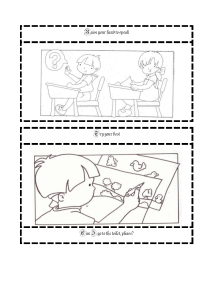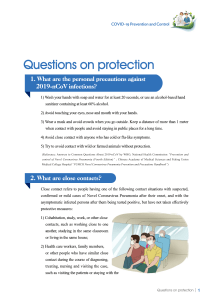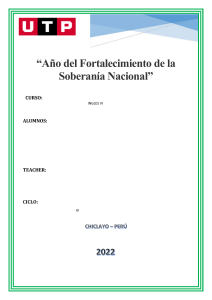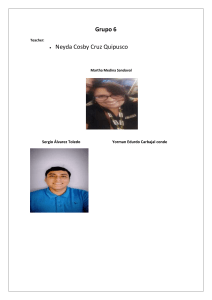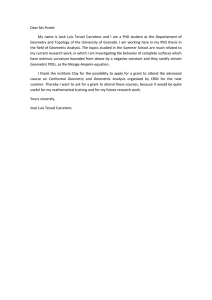Navazo-Ostúa & Pérez Valencia 2022 Masks and emotional distance a visual study of human relationships in the Covid 19 pandemic (1)
Anuncio
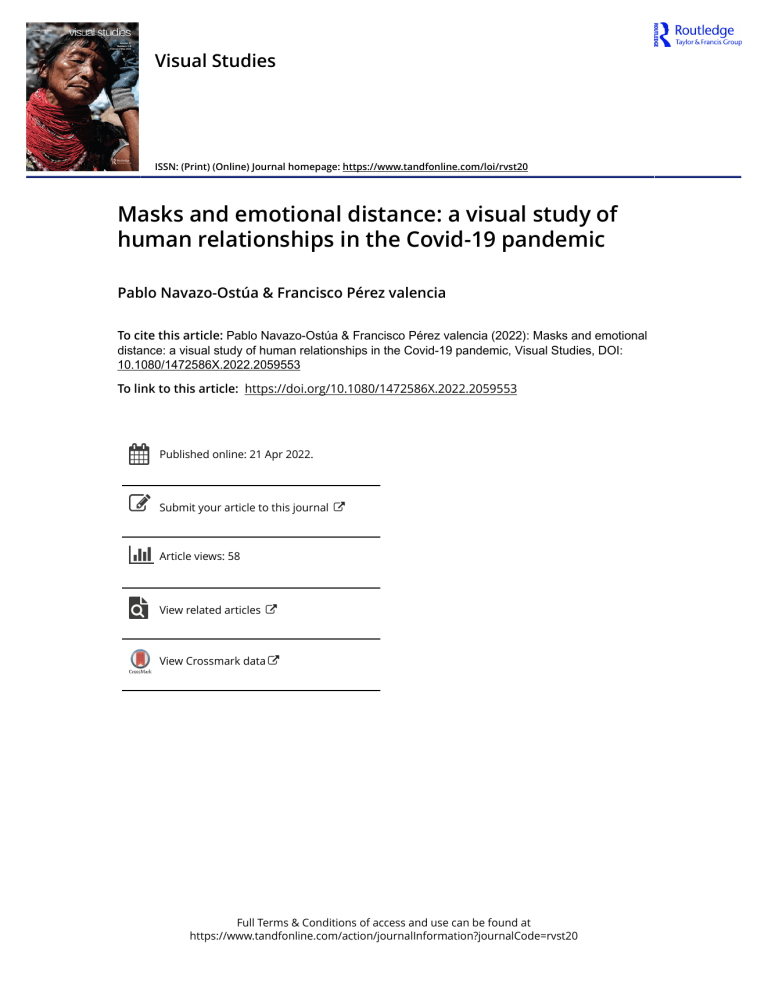
Visual Studies ISSN: (Print) (Online) Journal homepage: https://www.tandfonline.com/loi/rvst20 Masks and emotional distance: a visual study of human relationships in the Covid-19 pandemic Pablo Navazo-Ostúa & Francisco Pérez valencia To cite this article: Pablo Navazo-Ostúa & Francisco Pérez valencia (2022): Masks and emotional distance: a visual study of human relationships in the Covid-19 pandemic, Visual Studies, DOI: 10.1080/1472586X.2022.2059553 To link to this article: https://doi.org/10.1080/1472586X.2022.2059553 Published online: 21 Apr 2022. Submit your article to this journal Article views: 58 View related articles View Crossmark data Full Terms & Conditions of access and use can be found at https://www.tandfonline.com/action/journalInformation?journalCode=rvst20 Visual Studies, 2022 https://doi.org/10.1080/1472586X.2022.2059553 Masks and emotional distance: a visual study of human relationships in the Covid-19 pandemic PABLO NAVAZO-OSTÚA and FRANCISCO PÉREZ VALENCIA This study addresses the social impact of the pandemic in terms of its effects on communication and emotion in spaces of everyday domestic activity. The aim is to visually and formally portray the personal, professional and citizen reality in the daily use of face masks. The analysis includes the adoption, advocacy or resistance to them, through various representative characters of different, referential social sectors. The effect of masks on communication and emotional relationships is explored through photo portraits and qualitative interviews developed in a small community in Southern Spain. This work seeks to better understand the communicative, personal and social consequences of such preventive measures. Between various interlocutors, the correct perception of each other’s emotions and expressions is crucial to achieve effective communication. The emotions that we perceive visually influence both our own emotional expressions and our state of mind (Epstude and Mussweiler 2009). This is why the accuracy of emotion recognition and communicative expression is of vital importance, since it also determines the effectiveness of the messages transmitted between subjects (Joseph and Newman 2010). It is clear that, due to their protective function, face masks reduce the visibility of most facial expressions. They also reduce the accuracy of recognition of expressions and emotions. The main purpose of this study is focused on the visual portraits and stories that are extracted from the same testimonies, contextualised in a very specific place and time. The analysis of the data obtained after the interview process constitute the procedure of inquiry, based on qualitative information-gathering techniques. Our aim is to achieve an analytical framework for visual methods of research (Pauwels 2010) combining interviews based on life stories and visual portraits. The life stories portrayed here are based on personal testimonies and facial expressions that make up the sample. As Prosser & Schwartz suggested, the motivation is to stimulate comments not on the content of the photograph but on what is intimate to the interviewees that is ‘triggered’ by the photograph itself (Prosser and Schwartz 1998). Through them, we intend to portray a current reality, linked and shaped by the faces and experiences lived by the subjects themselves. As Wagner (2002) suggested in his analysis, we understand the portrait photography as a medium for illustrating the research findings with the methods involving interviews and Life Stories, as well as an even more relevant way of intervention for generating new ethnographic insights. Visual sociology and documentary photography, as Becker (1995) pointed out, are not less than social constructions, pure and simple. They resemble all the other ways of reporting what we know, or think we have found out, about the societies we live in (Becker 1995) (Figure 1). Our aim is to explore the habits and uses of a population belonging to the community of Sanlúcar de Barrameda (Cádiz). Within the community social fabric, six social domains were identified as representative of daily domestic activity. Among the different segments that shape the daily reality of the community are family, education, health, hospitality, culture and sports. The people representing each of the described domains were interviewed and photographed in their everyday environments. The domesticity of the photographs come Pablo Navazo-Ostúa PhD Degree Cum Laude in Information Sciences from Complutense University of Madrid since 2016/2017 academic year. Professor of Communication Degree at Loyola Andalucía University since 2018. He participates in several research projects, whose main contribution lies in his specialization in Cultural Studies, Design and Visual Communication. Master Professor in Political and Business Communication master course, as well as Digital Marketing master course at Camilo José Cela University. Research member of CIGMAP and specialist in Audiovisual and Contemporary Art. Co-founder and CEO in Visualize.es and national collaborator of TEDx Spain. Francisco Pérez Valencia PhD from the University of Seville, he teaches regularly at numerous universities in Spain and Latin America in the field of Creative and Experimental Museography, as well as in sensitive and emotional areas. Artist and museographer specialising in contemporary artistic languages, he is an outstanding innovator of exhibition practice and is present in some of the most representative art collections in Spain. He is currently Professor at the Universidad Loyola Andalucía. Since 2010, he has been developing a project for innovation in human organisations and business management, called The Emotional University, with an outstanding participation of culture and artistic creation. © 2022 International Visual Sociology Association 2 P. Navazo-Ostúa and F. Pérez Valencia FIGURE 1. The total sample photographed in their regular environments. from their aim to capture the spontaneity of everyday life. These are natural photographs, without any digital manipulation or correction. FIGURE 2. José Ángel, grandfather and Jimena, his granddaughter. FAMILY DOMAIN: THE STRENGTH OF THE FAMILY For José Ángel, the mask used in his photo is special, because it was specially made for him (Figure 2). He wears it in the most relevant moments, because it is different, more aesthetically pleasing than the rest. He is very aware of the challenge, he is currently facing with the pandemic and feels that the need for the mask will linger for a long time, to the extent that he would not mind continuing to wear it, even if it were not mandatory. Jimena is a creative child. She is always looking for ways to express herself. She has several masks but two of them were her favourites (the one pictured is one of them), the others make her uncomfortable, her ears hurt. She Masks and emotional distance 3 HOSPITALITY: THE PLEASURE OF A GOOD COFFEE FIGURE 3. Macarena, school teacher and María, her student. chooses them according to the outfit or situation. She cares because it’s all about the details. She is a responsible girl. She wears the masks while watching TV or when family members are around. She misses her grandparents. She has not seen her grandfather José Ángel since the beginning of the confinement in early 2020. EDUCATION DOMAIN: EDUCATION IS THE PRESENT Macarena is a primary school teacher (Figure 3). She now feels that each classroom is like a micro-school, with its own specific systems, particularities and obligations. The pandemic and the use of face masks for protection have changed things considerably within the classroom. Now students are not able to participate in collaborative work, where they worked in pairs, and some students served as tutors to others, who in turn, reciprocated in subjects where they felt most comfortable and talented. She spends many hours talking to her youngsters, breathing in her constant effort to be heard, even with a microphone. Maria is very mature for her age. She misses the collaborative activities in class, such as the dynamics that her teacher Macarena used to do last year, sharing her doubts with a colleague and trying to help each other. But she has generally adapted well to the new situation. She continues to express herself in the same way, because she also lets her body speak and she gestures naturally with her eyes and eyelids. She also uses her shoulders. When she cannot hear a classmate well, she asks them to speak louder. FIGURE 4. Rafa, hospitality professional and Ángel, a regular customer. Rafa is serious on the outside, but he has a sense of humour, he laughs a lot, especially at himself (Figure 4). He loves working with his customers. Rafa boasts a sixth sense about his clients. He believes that now the mask provides the information, along with customers’ tics such as touching it excessively or the ones that pull it up because it constantly slips off, representing new acquired quirks that matters to him. He recognises that everything is a bit colder and that he misses their facial features and what this meant for the communication potential. Angel is Rafa’s best customer. He usually gets Rafa to come out of the bar counter and sit at his table. He always wears a mask, as he is required to do for safety. He now recognises that his visits to Rafa’s cafe have become spaced out. He prefers peace and quiet. Ángel always spoke with his whole face, moved his eyebrows, smiled frequently and let others see some small wrinkles in the corner of his eyelids. He continues to see a powerful reason to observe and be attentive in the eyes of others. SPORTS DOMAIN: LOOKING INTO THE EYES IS WINNING A FIGHT Luis is a boxing coach (Figure 5). Precisely a sport where the gaze has an essential role and becomes in itself a vast compendium of communication, due to the direct contact between both opponents. For Luis, the great difficulty FIGURE 5. Luis, coach and Daniel, boxer. FIGURE 6. José Luis, the team leader and Rosa, a dental assistant. 4 P. Navazo-Ostúa and F. Pérez Valencia with the use of the mask comes during cardio dominance exercises, such as punching the bag, where the mask prevents breathing and easy recovery. It becomes impossible. Luis also recognises that he must now scream more in order to be heard by the group of trainees. Daniel has not competed since the beginning of the pandemic. He says he feels more prepared, his weight is under control and he has a high concentration capacity, which have benefited from not being able to go out and focusing on his training. When Luis mentioned the fact that it is important to look into the eyes, Daniel recognised that he could see whether he will win the fight or whether it will be difficult in his opponent’s eyes. HEALTHCARE DOMAIN: THE FRONTLINE José Luis has been wearing the medical safety mask for more than 20 years (Figure 6). They are inseparable. He is a dentist. He acknowledges that he has not become sick in many years and believes that this may be largely due to the strict control he has with regard to his patients, which causes him to become isolated from his surroundings. He has not seen the full face of anyone on his team since the beginning of the pandemic. For José Luis, wearing a mask and demanding safety in his environment is routine. Rosa is in absolute harmony with the mask. She is concerned that others cannot see her smile, because she is the first team member who assists the patient. She tries to make up for this by maintaining a lively tone in her conversation, even on the phone, raising her eyes and trying to display increased expressivity. Within the office, she wears a professional FFP2 mask. Her husband had COVID-19, so she is meticulous about safety within the home. In the practice, she only removes it at lunchtime, only for five minutes and away from the rest of the team. She assists the customers and tries to be close to them. The mask does not prevent her from doing so. She tries harder. FIGURE 7. Isidro, musician and Belén, actress. CULTURAL DOMAIN: CULTURE OR LIFE Isidro feels that his concern and memory are being tested at this time (Figure 7). He feels no hesitation in wearing the mask. He lives it as if it were part of a dystopian or science fiction work, something unreal, and yet he fully assumes it. From his concert tours, he especially remembers that, more than 20 years ago in Japan, it was not uncommon for him to wear a mask in ordinary life. At that time, he understood that it was more a question of education than health. He is taking the safety requirements very seriously. Belén, as a professional actress, struggles with wearing a mask during rehearsals and also the absence of physical contact with her colleagues, in order to be able to express using the five senses. She hopes that this situation is temporary and that she will return to the theatre stages like before. Belén is a woman who is full of life. Wearing a mask brings about some internal conflicts. Personally, her major struggle lies in how to kiss those she truly loves. CONCLUSIONS Masks entered the lives of most of these people during the pandemic and beyond their protective function, they have also served as a visual and collective reminder of the prevailing threat of the virus. While, on the other hand, the widespread use of face masks has represented, along with other factors, a partial return to a normalised life. This element of preventive health care is therefore understood as a multiple, complex and polysemic social symbol. It is associated, on the one hand, with threat and fear, while, on the other hand, it is associated with greater freedom and health safety. The primary function of masks to effectively stop the spread of the virus is recognised by all, but prolonged use can have collateral consequences for social relations. Reducing the ability to recognise emotions, social empathy in interactions and highlighting the fact that masks influence, to a greater or lesser extent, the closeness of emotional relationships. As Belting indicates, when an interlocutor uses a mask, we can only see the eyes of the mask-wearer. At that point, the gaze, which we can suddenly no longer interpret, acquires an uncanny force that renders us powerless. When we find ourselves restricted to such a gaze, disembodied from the face, we are no longer capable of exchanging glances (Belting 2017). Masks not only separate the interlocutors in a physical and figurative sense, but they can also generate a feeling of uncertainty and doubt among the subjects themselves. This work is determined by the wealth of projections, motives and possibilities reflected in this study. The Masks and emotional distance different individual positions and attitudes towards the same threat and to the same measure are portrayed here. Therefore, the use of this common element – the facial mask – as a shared element to protect each other, is still open to discussion as to whether it will modify communication and emotional expression in the long run. DISCLOSURE STATEMENT No potential conflict of interest was reported by the author(s). ORCID Pablo Navazo-Ostúa http://orcid.org/0000-00030530-3652 Francisco Pérez Valencia http://orcid.org/0000-00031824-0793 REFERENCES Becker, H. 1995. “Visual Sociology, Documentary Photography, and Photojournalism: It’s (Almost) all a 5 Matter of Context.” Visual Studies 10: 5–14. doi:10.1080/ 14725869508583745. Belting, H. 2017. Face and Mask: A Double History. New Jersey: Princeton University Press. Epstude, K., and T. Mussweiler. 2009. “What you Feel is How you Compare: How Comparisons Influence the Social Induction of Affect.” Emotion 9 (1): 1–14. doi:10.1037/ a0014148. Joseph, D. L., and D. A. Newman. 2010. “Emotional Intelligence: An Integrative Metaanalysis and Cascading Model.” Journal of Applied Psychology 95 (1): 54–78. doi:10.1037/a0017286. Pauwels, L. 2010. “Visual Sociology Reframed: An Analytical Synthesis and Discussion of Visual Methods in Social and Cultural Research.” Sociological Methods & Research 38 (4): 545–581. doi:10.1177/ 0049124110366233. Prosser, J., and D. Schwartz. 1998. “Photographs Within the Sociological Research Process.” In Image-based Research: A Sourcebook for Qualitative Researchers, edited by J. Prosser, 115–130. London: Falmer Press. Wagner, J. 2002. “Contrasting Images, Complementary Trajectories: Sociology, Visual Sociology and Visual Research.” Visual Studies 17 (2): 160–171. doi:10.1080/ 1472586022000032233.

